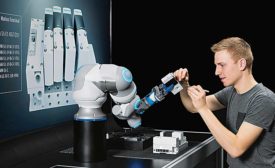Automated Assembly Systems
Buoyed by efforts to boost domestic production of EVs and electronics, manufacturers are investing in their assembly operations.
Read More
Screwdriving Gripper Mimics Two-Handed Assembly
Researchers have developed a single end-of-arm tool that can simultaneously hold a part in place and install it at the same time.
November 29, 2022
Autonomous Mobile Manipulators for Aerospace Assembly
A new approach for assembling composite aerostructures uses autonomous mobile robots and lightweight assembly jigs that compensate for deformation.
November 29, 2022
Conveyor-Less Micro Factories for Urban Car Production
Automakers don’t need conveyors to transport vehicles on assembly lines - the vehicles can move themselves.
November 28, 2022
Smart Factories: Here and Now
Highly automated smart factories are no longer a pie in the sky concept.
November 23, 2022
Automated Assembly System Roundup
Medical devices and faucets are among the myriad items made on automated assembly systems.
November 2, 2022
Never miss the latest news and trends driving the manufacturing industry
Stay in the know on the latest assembly trends.
JOIN TODAY!Copyright ©2025. All Rights Reserved BNP Media.
Design, CMS, Hosting & Web Development :: ePublishing











